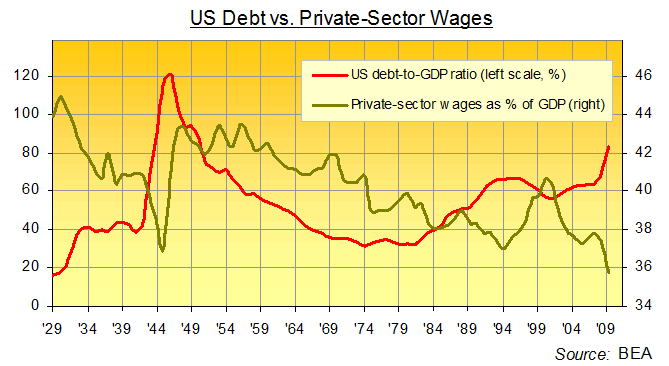The Link Between Public Debt and Private Wages
Interest-Rates / US Debt Jul 02, 2010 - 05:41 PM GMTBy: Adrian_Ash
BETWEEN V.E. Day in 1945 and June 1947, the United States shrank its armed forces from twelve million people to around 1.5 million.
The impact on the economy – and on the US Treasury's then record debts – is hard to overstate...

Indeed, at either end of our chart, national debt – as a proportion of gross domestic product – shows a mechanical relationship with private-sector income. Because it falls as wages rise, and vice versa. That's unsurprising, given that privately-generated income is always the prime source of net tax receipts.
But the chart shows three further things, however, which Washington's planners (if not private and foreign Treasury-bond holders) might also consider:
#1. The share of GDP going to private-sector US wages has steadily declined since the post-war demobilization. Yes, there's been a boom in corporate profits. Yes, GDP clearly counts many more activities today than it did. But there has also been a steady nationalization of the US economy, and it is accelerating.
#2. Outside total war, private incomes have never been smaller compared against public debt. Falling from a ratio of 2:1 as the Great Depression began to hold steady around to 1:1 across the 1960s, '70s, '80s and '90s, private incomes have now sunk to four-tenths the size of the national debt. The record low, hit in 1945, was 0.32.
#3. Demobilization was vital in the mid-to-late 1940s to a) stemming debt growth, and b) also paying debt down. Lacking any such shock today, however, the current administration may as well target 4% annual GDP growth in its forecasts. But even that growth would merely curb the debt (or so it's hoped) to $20 trillion by the end of this decade.
Still, what chance of demobilization today? Returning 10 million people to the private jobs market, amid the current economic debate, ain't going to happen. So neither will a turnaround in America's fast-rising trend of debt-to-GDP.
By Adrian Ash
BullionVault.com
Gold price chart, no delay | Free Report: 5 Myths of the Gold Market
Formerly City correspondent for The Daily Reckoning in London and a regular contributor to MoneyWeek magazine, Adrian Ash is the editor of Gold News and head of research at www.BullionVault.com , giving you direct access to investment gold, vaulted in Zurich , on $3 spreads and 0.8% dealing fees.
(c) BullionVault 2010
Please Note: This article is to inform your thinking, not lead it. Only you can decide the best place for your money, and any decision you make will put your money at risk. Information or data included here may have already been overtaken by events – and must be verified elsewhere – should you choose to act on it.
© 2005-2022 http://www.MarketOracle.co.uk - The Market Oracle is a FREE Daily Financial Markets Analysis & Forecasting online publication.



